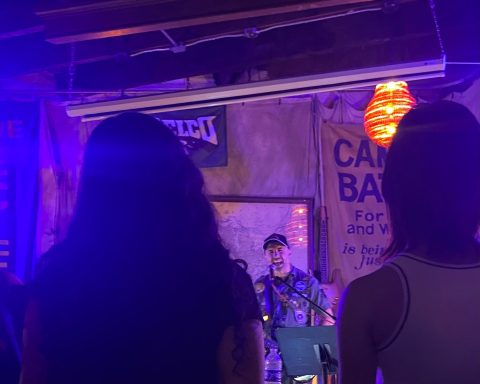
(Allegra Pocinki/The Phoenix)
On Saturday evening November 20, the Swarthmore College Chorus wowed audiences with an impressive performance, showcasing both the range and power of the human voice. Presented by the Swarthmore College Department of Music and Dance, the chorus, accompanied by Swarthmore’s orchestra, performed two pieces, “Vesperae Solennes de Confessore” by Wolfgang Amadeus Mozart and “Dido and Aeneas” by Henry Purcell.
The chorus is composed of students, faculty and members of the local campus community and is directed by John Alston, Professor of Music at the college and also the founder of Chester Children’s Chorus.
The first performance was of Mozart’s “Vespers,” which translates roughly into English as “Solemn Vespers for a Confessor.” Generally, the word “vespers” refers to evening prayers in a variety of Christian liturgical traditions.
Composed around 1780, the piece belongs to a selection of Mozart’s oeuvre known as the “Sacred Works” because the “Vespers” are musical adaptations of Christian and liturgical writings. The works that were set to music for a chorus and orchestra were five of the Christian Psalms as well as the “Magnificat,” also known as the canticle of Mary.
Mr. Alston introduced the performance by describing the “Vespers” as “a conversation and an argument, an absolutely fiery 25 minute piece of music with two of the most beautiful soprano solos ever written.” He said, “Mozart is often not concerned with words. Musical dialogue is in the composition.” Though “fiery” is not often the word one thinks of when talking about evening prayers, Saturday evening’s performance demonstrated precisely how it was possible.
Hunter Bayliss ’12, who has been involved with the Chorus for four years and who performed in Saturday’s concert, gave his take on the “Vespers.” He noted that the piece, composed relatively early in Mozart’s career, is a concerto, a specific variety of musical composition (usually in musical three parts) in which a solo instrument — in this case a harpsichord — is accompanied by an orchestra.
Far from “solemn” as the title suggests, the “Vespers” offered a soaring and invigorating performance. The words, spoken in Latin, did indeed fade into the background as the chorus joined with the orchestra to produce a remarkable piece of music.
Four out of six of the psalms/canticles featured solos, ranging from soprano to bass parts. Performers included Nina Kokegar ’13, Daniel Cho ’15, Gautam Mohan ’15, Eugene Prymak ’13 and Psychology Professor Julia Welbon. Darien Sepulveda ’15 and Holly Kinnamont ’12, also sang two solos. Sydni Adler ’13, Chris Magano ’14 and Julia Finkelstein ’13 all made their first of two appearances that evening, returning for the second piece later that evening night.
Eric Rodriguez ’13, who was in the audience Saturday evening, noted that Finkelstein and Kinnamont were especially “expressive and engaging” in their performances. “Though I was not reading along with the words, they almost didn’t matter. I only realized near the end of one part that they were even singing ‘Amen,’” Rodriguez said.
The second piece of the evening, “Dido and Aeneas,” was a shift both in tone and musicality. Composed by seventeenth-century English and Baroque organist Henry Purcell, the opera is a musical adaptation of ill-fated love between Dido, Queen of Carthage, and the Trojan hero Aeneas. Consisting of three acts, the piece oscillates between humor and tragedy.
Director John Alston framed the performance by noting in his introduction the humorous singing of “the Witches” in the Chorus interpretation of the opera and that it contained the “world’s greatest pickup line.” Mr. Alston challenged the audience to try it themselves and see if “Aeneas has no fate but you” translates well offstage.
Bayliss, who sang Aeneas’ part, noted that these fate-spinning and malevolent witches are an example of an interesting influence of Shakespeare’s “Macbeth” on the opera. Unlike the tragic witches of that play, Adler and Sophia Naylor ’13 turned up the humor in their performances by singing their lines in a high, nasal tone and cackling like something out of “Hocus Pocus.” Moreover, Bayliss described the music as “fun” to perform, and while the arias of Aeneas are not flamboyant, “the innuendo and bravado of the lines make it hard not to find comedy in the writing.”
Molly Siegel ’12, who went to last year’s Chorus concert but has never seen an opera at Swarthmore previously, noted, “I especially enjoyed the piece’s sexy second half, which truly showcased the violent and lustful relationship between Dido and Aeneas.”
Indeed, the second half of the opera takes a turn for the tragic, and the death of Dido — accompanied by the famous musical piece “Dido’s Lament” — concludes in a much different mood. Siegel noted that the performance of Genevieve McGahey ’12 as Dido was excellent. “I would have been crying by the end of the opera if it wasn’t for the witches,” she said.
Other performances of note included solos by Steven Barrett ’13, who sang both the parts of the Sorceress and the Spirit, showcasing his incredible vocal range. Additionally, Jenny Koch ’13 played the part of Belinda, Dido’s attendant, and Julia Finkelstein ’13 as The Second Woman, another of Dido’s attendants. Harry Apostoleris ’12 and Chris Magnano ’14 also made appearances as sailors.
Overall, the Swarthmore College Chorus offered an approachable and varied showcase of both vocal excellence and musical ability. The appearance of a harpsichord was refreshing and incredibly interesting, and the “Vespers” were an appropriate piece for its performance. Also, in terms of opera, “Dido and Aeneas” was around 45 minutes long, offering a digestible but emotionally complex piece. Chorus concerts are performed twice a year, once each semester, so the spring should offer an equally compelling performance for those unable to attend this time.













